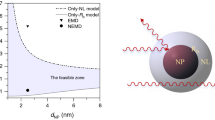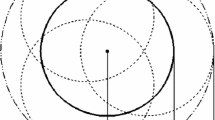Abstract
A model has been proposed here for estimating the thermal conductivity of a nanofluid based on the mechanism that the nanoparticles dispersed within the nanofluid undergo Brownian motion and repeatedly collide with the heat source. Molecular dynamics (MD) simulation has shown that there is a pulse-like heat pick up by the nanoparticles within 10–50 ps during the collision. After the collision the nanoparticles undergo Brownian motion in the base fluid and release the excess heat to the surrounding fluid within 2–5 ms. The thermal evolution during Brownian motion of the nanoparticles has been modeled by stochastic analysis. Simulations have shown that the additional heat transfer caused by the collision of the nanoparticles with the heat source contributes significantly to the characteristic thermal conductivity of the nanofluid. The prediction of the present model has shown a reasonable agreement with the experimental data available in literature for ethylene glycol based copper nanofluid.
Access this chapter
Tax calculation will be finalised at checkout
Purchases are for personal use only
Preview
Unable to display preview. Download preview PDF.
Similar content being viewed by others
References
J. A. Eastman, S. U. S. Choi, S. Li, W. Yu and L. J. Thompson, “Anomalously increased effective thermal conductivities of ethylene glycol-based nanofluids containing copper nanoparticles”, Applied Physics Letters, 78 (2001), 718–720.
S. U. S. Choi, Z. G. Zhang, W. Yu, F. E. Lockwood and E. A. Grulke, “Anomalous thermal conductivity enhancement in nanotube suspensions”, Applied Physics Letters, 79 (2001), 2252–2254.
S. K. Das, N. Putra, P. Thiesen and W. Roetzel, “Temperature Dependence of Thermal Conductivity Enhancement for Nanofluids”, Journal of Heat Transfer, 125 (2003), 567–574.
H. E. Patel, S. K. Das, T. Sundararajan, A. S. Nair, B. George and T. Pradeep, “Thermal conductivities of naked and monolayer protected metal nanoparticle based nanofluids: Manifestation of anomalous enhancement and chemical effects”, Applied Physics Letters, 83 (2003), 2931–2933.
S. Lee, S. U. S. Choi, S. Li and J. A. Eastman, “Measuring Thermal Conductivity of Fluids Containing Oxide Nanoparticles”, Journal of Heat Transfer, 121 (1999), 280–289.
R. K. Shukla and V. K. Dhir, “Study of the effective thermal conductivity of nanofluids”, in: Proceedings of the ASME International Mechanical Engineering Congress and Exposition (Orlando, Florida, USA), November 5–11, 2005, pp. 1–5.
P. Bhattacharya, S. K. Saha, A. Yadav, P. E. Phelan and R. S. Prasher, “Brownian dynamics simulation to determine the effective thermal conductivity of nanofluids”, Journal of Applied Physics, 95 (2004), 6492–6494.
S. P. Jang and S. U. S. Choi, “Role of Brownian motion in the enhanced thermal conductivity of nanofluids”, Applied Physics Letters, 84 (2004), 4316–4318.
R. Prasher, P. Bhattacharya and P. E. Phelan, “Brownian-Motion-Based Convective-Conductive Model for the Effective Thermal Conductivity of Nanofluids”, Journal of Heat Transfer, 128 (2006), 588–595.
K. C. Leong, C. Yang and S. M. S. Murshed, “A model for the thermal conductivity of nanofluids-the effect of interfacial layer”, Journal of Nanoparticle Research, 8 (2006), 245–254.
R. Prasher, W. Evans, P. Meakin, J. Fish, P. Phelan and P. Keblinski, “Effect of aggregation on thermal conduction in colloidal nanofluids”, Applied Physics Letters, 89 (2006), 143119.
J. C. Maxwell, A Treatise on Electricity and Magnetism, 2nd ed., Oxford University Press, Cambridge, 1904, pp. 435–441.
R. L. Hamilton and O. K. Crosser, “Thermal Conductivity of Heterogeneous Two-Component Systems”, I & EC Fundamentals, 1 (1962), 187–191.
W. John, G. Reischl and W. Devor, “Charge transfer to metal surfaces from bouncing aerosol particles”, Journal of Aerosol Science, 11 (1980), 115–138.
J. Garg, B. Poudel, M. Chiesa, J. B. Gordon, J. J. Ma, J. B. Wang, Z. F. Ren, Y. T. Kang, H. Ohtani, J. Nanda, G. H. McKinley, and G. Chen, “Enhanced thermal conductivity and viscosity of copper nanoparticles in ethylene glycol nanofluid”, Journal of Applied Physics, 103 (2008), 074301.
Author information
Authors and Affiliations
Editor information
Editors and Affiliations
Rights and permissions
Copyright information
© 2013 TMS (The Minerals, Metals & Materials Society)
About this paper
Cite this paper
Ghosh, M.M., Rai, R.K. (2013). Modelling Heat Transfer in Nanofluids Based on Coupled Md-Stochastic Simulation. In: Marquis, F. (eds) Proceedings of the 8th Pacific Rim International Congress on Advanced Materials and Processing. Springer, Cham. https://doi.org/10.1007/978-3-319-48764-9_348
Download citation
DOI: https://doi.org/10.1007/978-3-319-48764-9_348
Publisher Name: Springer, Cham
Print ISBN: 978-3-319-48586-7
Online ISBN: 978-3-319-48764-9
eBook Packages: Chemistry and Materials ScienceChemistry and Material Science (R0)




